The Mopoke or Tawny Frogmouth – For Children
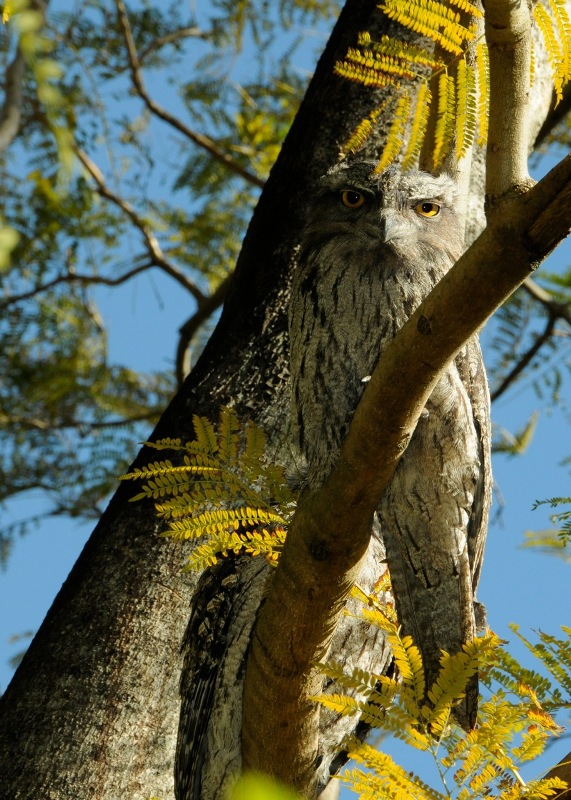 A few weeks ago we were telling a series of ‘more owls’ jokes to Palm Beach photographer Adrian Boddy – to which he replied with this wonderful photograph of a Tawny Frogmouth, or ‘Mopoke’. This bird, although you can see them during the day on occasion, is one of the many birds that flies at night and whose soft gentle call you may hear if awake and there is one nearby.
A few weeks ago we were telling a series of ‘more owls’ jokes to Palm Beach photographer Adrian Boddy – to which he replied with this wonderful photograph of a Tawny Frogmouth, or ‘Mopoke’. This bird, although you can see them during the day on occasion, is one of the many birds that flies at night and whose soft gentle call you may hear if awake and there is one nearby.
This week we thought we’d share a few poems, a fairy story written by a Western Australian gentleman ninety one years ago, and a little bit about these beautiful birds. A Tawny Frogmouth, like all frogmouths, are named for their large flattened hooked bills and huge frog-like gape, which they use to capture insects.
In New South Wales we also have a town named after these birds, which we found out about when using Trove which we shared some information on last week. This seems to yet another named for these birds:
Mopoke Named It. Near Towamba (N.S.W) is a little township which received its name from the call of the mopoke! From a distance the Aboriginal peoples reckoned the mopokes were calling ''Wog Wog” so they gave the locality that name. Have listened to the old mopokes and though he! says 'More pork' when close to him, it sounds like 'Wog wog' at a distance.- W.P.T. Mopoke Named It. (1933, January 6). The Bombala Times(NSW : 1912 - 1938), p. 2. Retrieved from http://nla.gov.au/nla.news-article134558342
Wog Wog is in the South Coast region of New south Wales, inland from Eden. There is also a river named after this there.
The Tawny Frogmouth (Podargus strigoides) is an Australian species of frogmouth, and found throughout the Australian mainland, Tasmania and even southern New Guinea. Although related to owls, frogmouths are more closely related to nightjars and oilbirds. The Tawny Frogmouth was first described in 1801 by English naturalist John Latham. Its specific name is derived from the Latin stems "strix" "owl" (Latin: strix) and "-oides" "form" (Latin −oides). It belongs to the frogmouth family Podargidae, which also includes the other species of frogmouths like the Javan and Solomons Frogmouths. The frogmouth family has been around for about 56 million years, since the Eocene period.
Males and females look alike and are 35–53 cm (14–21 in) long. This very bulky species can weigh up to 680 grams (1.5 lbs) and, in overweight zoo specimens, up to 1400 grams (3.1 lbs). This species thus reaches the highest weights known in the Caprimulgiformes order. They have yellow eyes and a wide beak topped with a tuft of bristly feathers. They make loud clacking sounds with their beaks and emit a reverberating booming call.
Tawny Frogmouths hunt at night and spend the day roosting on a dead log or tree branch close to the tree trunk. Their camouflage is excellent — staying very still and upright, they look just like part of the branch. The Tawny Frogmouth is almost exclusively insectivorous, feeding rarely on frogs and other small prey. They catch their prey with their beaks rather than with their talons, another way in which they are different from owls. Owls fly around at night hunting food, but Tawny Frogmouths generally remain sitting very still on a low perch, and wait for food to come to them. They sometimes drop from their perch onto prey on the ground. The bird's large eyes and excellent hearing aid nocturnal hunting.
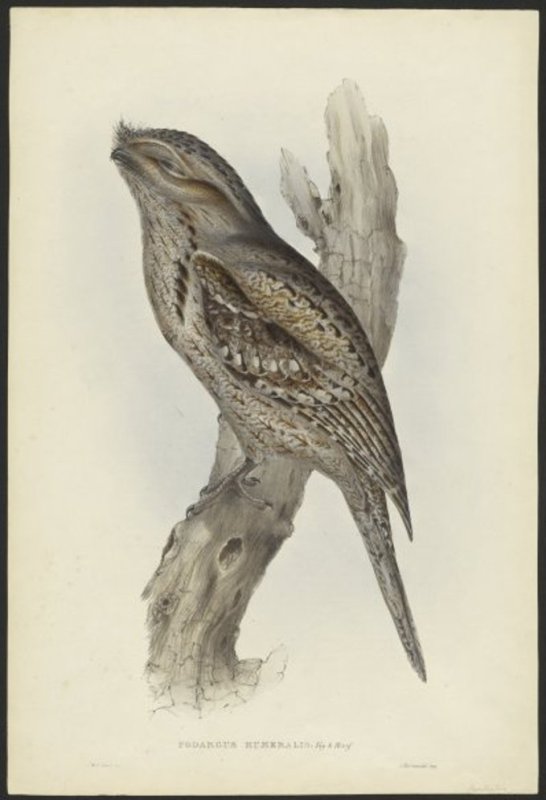 Tawny Frogmouth pairs stay together until one of the pair dies. They breed from August to December. They usually use the same nest each year, and must make repairs to their loose, untidy platforms of sticks. The female or mum Tawny Frogmouth lays two or three eggs onto a lining of green leaves in the nest. Both male and female take turns sitting on the eggs to incubate them until they hatch about 25 days later. Both parents help feed the chicks.
Tawny Frogmouth pairs stay together until one of the pair dies. They breed from August to December. They usually use the same nest each year, and must make repairs to their loose, untidy platforms of sticks. The female or mum Tawny Frogmouth lays two or three eggs onto a lining of green leaves in the nest. Both male and female take turns sitting on the eggs to incubate them until they hatch about 25 days later. Both parents help feed the chicks.
Picture to right: Podargus humeralis Vig. & Horsf. By Gould, Elizabeth, 1804-1841., [London : s.n., 1848] [London] : C. Hullmandel imp. 1 print : lithograph, hand col.; 55.4 x 37.2 cm. nla.pic-an11135263, courtesy National Library of Australia.
Tawny Frogmouth. (2014, February 18). In Wikipedia, The Free Encyclopedia. Retrieved from http://en.wikipedia.org/w/index.php?title=Tawny_Frogmouth&oldid=596057379THE MOPOKE.
(Written by Olwyn Lacey.)
The mopoke is a solemn bird,
And I suppose you all have heard
That he has feathers, grey, like smoke,
And he can never see fun in a joke.
He fits up high upon a tree
And looks below to watch and see
Everything that goes his way.
But never a different word does he say,
But ‘Mopoke— mopoke '
He lives in the forest far away.
As solemn at night as in the day.
He owns a very mournful croak.
And is sheltered by the dark night's cloak,
The moon shines down upon him there,
But all he does is git and stare.
Though never seen, he's often heard
By his mysterious and gloomy word —
Mopoke — Mopoke !
(No. of points 6. - aged 13)
THE MOPOKE. (1938, April 14). The Central Queensland Herald (Rockhampton, Qld. : 1930 - 1956), p. 64. Retrieved from http://nla.gov.au/nla.news-article70577918
A LEGEND FOR THE LITTLE ONES - Mopoke and Chip-Chip.
By Jean Dell
One day, long, long ago,
before the birds of Australia had sweetness in ]their voices ' and
prettiness in their plumage; before the bush had perfume in its flowers
and beauty in its blossoms; before the running brooks made music as they
tossed and tumbled on their sandy beds; Wunda, a boy fairy, was
wheeling his baby sister. Mopoke, in a fairy pram on a green hilltop. His mother, the queen, had warned him not to take his hand off the fairy chariot for an instant.
"For," she said, "if you do, the pram will run down the hill, and little Mopoke will be lost to us forever."
It
was Wunda's love for Mopoke that made him forget this warning. At the
top of the hill he saw some other fairy children gathered around a
nursery basket.
"Come here. Wunda," they called, "and see if our fairy baby is not as sweet and beautiful as Mopoke."
-And Wunda alarmed at such a challenge, rushed over, leaving Mopoke on the very brink of the hill. After
fearfully examining the fairy child, he proudly exclaimed: "I will
bring Mopoke here, and then you will be sorry for saying that any fairy
baby can compare with her "
He reached the place where he had left her, only to see the fairy pram far, far below, almost at the bottom, of the hill» -
He
could just make out Mopoke's pretty hands helplessly waving to him, and
hear her sweet, frightened Voice calling to him to save her.
Running,
more swiftly than ever a fairy boy had run before, fear, and love
giving him a double speed. He came to the distant valley; but there was
no sign of little Mopoke. He searched every nook and corner of the
valley, and climbed all over the opposite hillside, calling "Mo-poke!
Mopoke!" but there was no answer to his agonised cry.
Night came up out of the deep places, until even the tops of the mountains were covered with darkness,"Mopoke!. Mopoke !"
Calling, calling; seeking; seeking; but never finding.
It was just as the queen had said little Mopoke was lost to them forever.
Surely never before "had there been such a sorrowful, hopeless quest in Fairryland, ' .
Never
before had there, been such a bitter story as that told by Wunda when
he reached his father's palace at midnight, bruised, bleeding, and
heartbroken. But, in Fairyland, great sorrow can be turned into marvellous joy, as we shall see.
The
king was a just man but the loss of the most wonderful fairy baby the
world had ever known made him angry as well as sad; and his sentence of
punishment on poor Wunda was terrible Indeed.
"You shall be turned
into an owl" he said. "Your eyes will be closed to the beauties of
daylight. While the sun shines you will perch in the darkest place of the
forest. When night rises, and every other bird is happily at rest, you
will fly in the darkness seeking the sister you have lost. All through
the night you will call 'Mopoke! Mopoke!' so that men will come to know
you by that" name. Thus, though little Mopoke he perished, her name will
survive. And so the miserable Wunda, losing at once his name and his
fairy form, flew into the night, an owl condemned to call far ever
"Mopoke: Mopoke."
Calling, calling, but getting no answer. Seeking, peeking, but never finding.
The
chip-chip is one of the tiniest birds in Australia; and at the time of
little Mopoke’s disappearance it built a very tiny nest, in which it
laid three white little eggs, all spotted with pink.
Small as the
nest was, the lazy cuckoo did not hesitate to lay an egg therein; for
she built no nest of her own, being under the spell of the bed fairies.
When the eggs were hatched, the young cuckoo grew so big that the
little chip-chips had not sufficient room, and some them, and some times
all of them, were pushed over the side by the bad bird. He was so
greedy, too, that the poor birds often went to sleep hungry, for their
parents were compelled to feed the unwelcome guest.
One day the
adopted bird, having grown so that he could fly away, young chip-chip,
who had great bravery in his little body, said to his father:
'The
cuckoo has thrust out my baby brother, so that he will never be able to
fly. My sister and I have been squeezed and trampled, so that our wings
will not be strong for a long time; and he has taken half our food, so
that we are still in the nest when we ought to be on the wing. "When I
am able to fly far away I will go out into the great world seeking, a
fairy who will tell me a secret that may be used so that the family of
chip-chips who have suffered so much shall never, more be treated thus."
Then father chip-chip told ma brave son the story of the loss of little Mopoke, and of the condemned owl who now bore her name.
"If
you are fearless enough," he said, "to fly into the depths of the forest
at midnight and seek out this owl, he will show you how to over-come
the cuckoo, for great sorrow has made him wonderfully wise."
Thoughts
of this great mission caused the young bird to grow strong, and made
his heart bigger than any that had ever beaten in a tiny feathered
breast.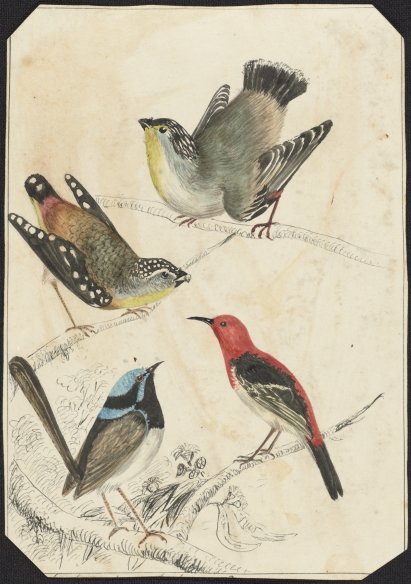 His father noted these happy signs, and one night he said, "Go to-night, my brave little son!"
His father noted these happy signs, and one night he said, "Go to-night, my brave little son!"
"Oh! be careful," said his frightened sister.
"Oh! come back again!" said his anxious mother.
And
the little chip-chip flew strongly and fearlessly through the darkness
until he heard the mournful cry that has echoed in the midnight forest
ever since beautiful Mopoke was lost by Wunda:
"Mopoke! Mopoke!"
Guided by the sad voice, the tiny bird flew till he found the mopoke perched on a limb overhanging a stream.
And it was as his father had said. Out of a heart, filled with sorrow there flowed wonderful words of wisdom.
If
you wish to know what the mopoke said to the chip-chip, you need but to
examine, the nest of the chip-chip to-day. You will not find an open
nest that any lazy cuckoo can enter, it is a large nest cunningly
contrived so that only a tiny bird can go through the entrances. For
there are two holes, and a nest inside each doorway. In the bottom the
eggs are laid and hatched. In the top nest the father-bird sleeps during
the night. So has the cuckoo been confounded by the chip-chip. When the
first of these marvellous houses was built the spell of sorrow was
lifted from Wunda, as we shall call him once again.
And Mopoke, the sweet and beautiful lost fairy-baby, was recalled from her wanderings and became the 'Fairy of the Bush. '
She
has put sweetness into, the voices, and prettiness into the plumage, of
the birds. She has put perfume into the flowers and beauty into the
blossoms of the bush. And the brooks; that babble gladly beneath the
shady trees, tossing and tumbling on their sandy beds, sing the happy
songs taught them by the Fairy of the Bush.
Above right: Spotted pardalote, Scarlet honeyeater, Superb blue wren and Striated pardalote by Louisa Atkinson, 1834-1872. [186-]nla.pic-an8136473 courtesy National Library of Australia
You can
never gaze Breathlessly on a scene of dazzling beauty as you chain your
daisies on the green bank of some sparkling stream; you can never
listen, entranced, to the burst of bright song from bird or bush without
thinking of the happiness that would be lost to the world if little
Mopoke had not been lost on the hillside one day, long, long ago.
If
at night you hear Wunda call "Mopoke! Mopoke!" you will be happy with
him, for you will know that he is calling some wanderer home. And,
although his eyes are blind by day, he sees at night all the beauties
that the Fairy of the Bush has breathed upon the world:
He sees
more. For if you ever pass beneath a chip-chip's nest, that tiny bird
will, tell you that "Wunda, on many a happy night, wheels a fairy pram
in which may be seen the
sweetest and most beautiful child that Fairyland has ever known. "
Be sure it is the lost little mopoke, never to be lost any more through the long bright happy days.
Mopoke
and Chip-Chip. (1923, January 7). Sunday Times(Perth, WA : 1902 -
1954), p. 1 Section: Second Section. Retrieved from
http://nla.gov.au/nla.news-article58038720
*the Striated Pardalote is nicknamed the "chip-chip bird" and lives in central and western Australia - it is one of four species of pardalotes in Australia.
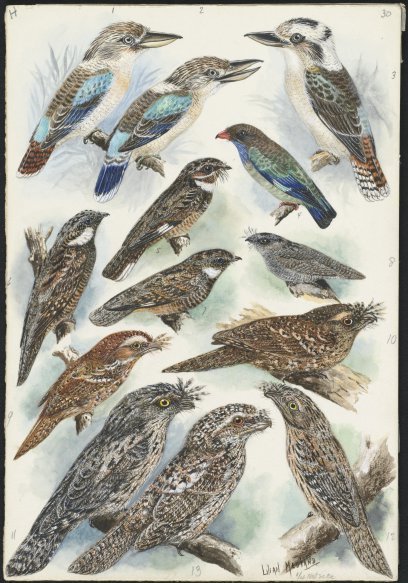 MOPOKE.
MOPOKE.
Mopoke! Mopoke!
Mysterious bird,
What loneliness
In thy one word.
Mopoke! Mopoke!
The vague profound
Of forest night
Is in the sound.
The shifting hollows
Are clogged with dark
My eyes can find
No standing mark,
Save in the distance-"
Oh, so far—
A hand of sky
Holds a sleepy star.
Night in the forest
Is solemn and strange.
And home is somewhere
Over the range.
How far have I come?
How far must go?
Ere my window shines
Like a star below?
Mopoke! Mopoke!
Tis nearer now;
I strain my eyes
To an unseen bough.
And .... though I listen
Nothing is heard,
Rustle of leaf
Nor rustle of bird:
But a fleeting darkness, .
Near .... or far? …
Blots for a moment
My sleepy star.
LOUIS LAVATER.
ORIGINAL POETRY. (1919, February 8). The Australasian(Melbourne, Vic. : 1864 - 1946), p. 38. Retrieved from http://nla.gov.au/nla.news-article140218352
Picture: Dacelo leachii and other birds [picture] c. 1930s by Lilian M. (Lilian Marguerite) Medland, 1880-1955. nla.pic-an14236954
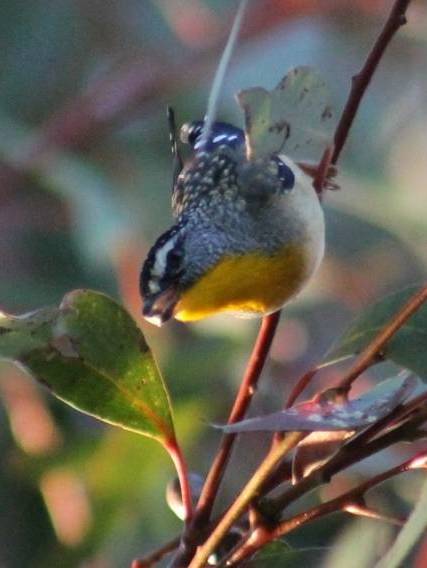 THE MOPOKE- While its dismal note is not easily forgotten when once heard, the mopoke or podargues is not a widely known bird. It is one of the birds of the night, and belongs to a group remarkable for the flat head, enormously wide mouth, large eyes, and owl like plumage. Really a species of owl, the mopoke is one of a class of birds which go under the name of nightjar (derived from the nocturnal habits and jarring utterances on the wing) in other parts of the world. Other names as "frogmouth" and "goatsucker" have been applied, the latter due to the once-popular belief that the bird actually milked goats. The notion probably arose from the habit of these birds seeking their prey usually at dusk and near the ground in pastures with cows and goats. Their strange leaping motions, together with their capacious mouths, led to fantastic ideas entirely without foundation. The mopoke or ‘morepork’ is the popular vernacular for the bird in the Australian bush, the name being derived from the peculiar cry of two syllables resembling the word "mopoke." The first part of the word is uttered short, with a more decisive and prolonged terminal. Many assert that the cry closely resembles "more pork," but the writer is of opinion that "mo-poke" is more aptly suited to the sound. The mopoke is about the size of ;a ere.', with long and powerful wings. Its plumage is light and of a downy texture. At the edges of their wing feathers- down is also present, giving the bird practically silent flight. Unlike the owls and hawks, tie prey is taken directly into the mouth. The snap of the bill is the only audible sound, and indicates that some insect has been caught in its flight. All food is captured in flight and moths form a conspicuous part of the bills-of-fare. It is not until evening that. this bird becomes active an it practically pursues its prey throughout the night uninterruptedly, only occasionally pausing fur a short period now and then. This bird is gifted with perfect protective colouring, the plumage being finely mottled in various shades of grey and grey-brown, which may be generally termed a rufous grey. The legs add feet are short and weak, and the bird moves about with a kind of shuffling motion. Although the bill is very short, the gape is extremely wide, as if tile head itself were divided, and the comparatively powerful mouth is surrounded by stiff hairs or bristles, assisting the bird in securing its agile prey. It avoids activity in the daylight. It passes the day in slumber, and rests on a horizontal branch of a tree in some shady place, always lengthwise, with head preferably lower than its body, thus facing the direction of the slope of the branch. This habit of perching lengthwise is not only dud to the somewhat feeble grasping power of the feet, but to the greater invisibility thus attained. The bird has a further protective habit when alarmed of stiffening itself in certain positions resembling a knot, or a broken or projecting stick, and so escapes casual observation. In fact, in conjunction with its protective colour, it is almost impossible to distinguish it from the surroundings.
THE MOPOKE- While its dismal note is not easily forgotten when once heard, the mopoke or podargues is not a widely known bird. It is one of the birds of the night, and belongs to a group remarkable for the flat head, enormously wide mouth, large eyes, and owl like plumage. Really a species of owl, the mopoke is one of a class of birds which go under the name of nightjar (derived from the nocturnal habits and jarring utterances on the wing) in other parts of the world. Other names as "frogmouth" and "goatsucker" have been applied, the latter due to the once-popular belief that the bird actually milked goats. The notion probably arose from the habit of these birds seeking their prey usually at dusk and near the ground in pastures with cows and goats. Their strange leaping motions, together with their capacious mouths, led to fantastic ideas entirely without foundation. The mopoke or ‘morepork’ is the popular vernacular for the bird in the Australian bush, the name being derived from the peculiar cry of two syllables resembling the word "mopoke." The first part of the word is uttered short, with a more decisive and prolonged terminal. Many assert that the cry closely resembles "more pork," but the writer is of opinion that "mo-poke" is more aptly suited to the sound. The mopoke is about the size of ;a ere.', with long and powerful wings. Its plumage is light and of a downy texture. At the edges of their wing feathers- down is also present, giving the bird practically silent flight. Unlike the owls and hawks, tie prey is taken directly into the mouth. The snap of the bill is the only audible sound, and indicates that some insect has been caught in its flight. All food is captured in flight and moths form a conspicuous part of the bills-of-fare. It is not until evening that. this bird becomes active an it practically pursues its prey throughout the night uninterruptedly, only occasionally pausing fur a short period now and then. This bird is gifted with perfect protective colouring, the plumage being finely mottled in various shades of grey and grey-brown, which may be generally termed a rufous grey. The legs add feet are short and weak, and the bird moves about with a kind of shuffling motion. Although the bill is very short, the gape is extremely wide, as if tile head itself were divided, and the comparatively powerful mouth is surrounded by stiff hairs or bristles, assisting the bird in securing its agile prey. It avoids activity in the daylight. It passes the day in slumber, and rests on a horizontal branch of a tree in some shady place, always lengthwise, with head preferably lower than its body, thus facing the direction of the slope of the branch. This habit of perching lengthwise is not only dud to the somewhat feeble grasping power of the feet, but to the greater invisibility thus attained. The bird has a further protective habit when alarmed of stiffening itself in certain positions resembling a knot, or a broken or projecting stick, and so escapes casual observation. In fact, in conjunction with its protective colour, it is almost impossible to distinguish it from the surroundings.
The writer once witnessed what appeared to be a commotion amongst this bird life in some tall timber on an out-back creek. The central object turned out to be a mopoke, which had evidently been rudely disturbed from its slumber. It was flying to and fro from tree to tree, closely pursued by other birds of all sizes and descriptions, including crows, magpies, sparrows, wagtails, and so forth, all vociferously screeching the while. Immediately the mopoke would alight on a branch of a tree it would be jostled off again. The wide concourse of "daylight" birds evidently realised that it was out of time and place for the mopoke to be about associating himself with their kind. Thus they were tantalising him in his comparatively helpless dilemma. The nest of the mopoke is a very primitive structure of sticks and he lives placed on the horizontal branch of a tree, with barely a sufficient dish to retain the eggs. They are two in number and spotlessly while the young are protectively coloured with down, and are not easily discovered. They rapidly attain their full size, and acquire the protective habits of their parents when very young in taking up their position lengthwise on a branch.
THE MOPOKE. (1911, April 22). Queensland Times (Ipswich) (Qld. : 1909 - 1954), p. 6 Edition: DAILY. Retrieved from http://nla.gov.au/nla.news-article112089976
MOPOKE OR FROGMOUTH?
"Interested" (Crawley) revives the old controversy whether the cry "mopoke, mopoke" heard during the hours of darkness is made by the mopoke or frogmouth or by the boobook owl. This question has long been a controversial one, and a really definite solution seems difficult to arrive at There is no doubt that many of thecalls attributed to the mopoke are really made by the boobook owl, but this does not say that the mopoke does not also give vent to the call which Its name suggests. Owing to the nocturnal habits ofboth birds it is extremely difficult to observe them when calling, but I have watched frogmouths on numerous occasions and heard them uttering their oft repeated "oom, oom," I have never detected any sound which would suggest the word mopoke. I have kept the birds in captivity for several months at a time, but failed to notice anything In addition to their low moaning note so that it would appear as if the boobook owl was responsible for at least the majority of the calls attributed to the frogmouth But there seem to be some grounds for the popular belief, as competent observers, who have kept frogmouths as pets, state that they have heard them give the characteristic call, in which case it would appear that the owl, and less frequently the mopoke, give vent to the call which, we know so well.
MOPOKE OR FROGMOUTH?. (1933, September 17). Sunday Times (Perth, WA : 1902 - 1954), p. 12 Section: Second Section. Retrieved from http://nla.gov.au/nla.news-article58703884
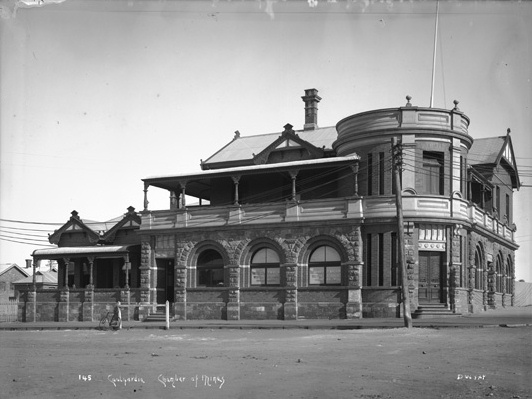 Jean Dell is actually a pen name for John Delaney, a man who was Coolgardie’s first schoolmaster and went on to work in the early Western Australian press. He was an associate and friend of many of the early Western Australian writers, including John Drayton. The imprisonment of John Drayton in 1904 was the first and, until the Browne–Fitzpatrick privilege case, 1955, the only time that anAustralian parliament punished somebody under parliamentary privilege provisions.
Jean Dell is actually a pen name for John Delaney, a man who was Coolgardie’s first schoolmaster and went on to work in the early Western Australian press. He was an associate and friend of many of the early Western Australian writers, including John Drayton. The imprisonment of John Drayton in 1904 was the first and, until the Browne–Fitzpatrick privilege case, 1955, the only time that anAustralian parliament punished somebody under parliamentary privilege provisions.Coolgardie is a small town in the Australian state of Western Australia, 558 kilometres (347 mi) east of the state capital, Perth. It has a population of approximately 800 people. Although Coolgardie is now known to most Western Australians as a tourist town and a mining 'ghost town', it was once the third largest town in Western Australia (after Perth and Fremantle). At this time, mining of alluvial gold was a major industry and supplied the flagging economy with new hope. Many miners suffered under the harsh conditions, but for a few, their finds made the hard work worthwhile.
The town was founded in 1892, when gold was discovered in the area. Australia had seen several major gold rushes over the previous three decades, mostly centred on the east coast, but these had mostly been exhausted by the 1890s. With the discovery of a new goldfield, an entire new gold rush began, with thousands flocking to the area. By 1898, Coolgardie was the third largest town in the colony, with an estimated population of 5,008 (3,151 men and 1,857 women). At its peak, 700 mining companies based in Coolgardie were registered with the London Stock Exchange. The town also supported a wide variety of businesses and services, including a railway, a swimming pool (first public baths in the state), many hotels and several newspapers. The gold began to decrease in the early 1900s, and by World War I, the town was in serious decline.
Coolgardie Chamber of Mines, Western Australia, ca. 1900 courtesy State Library of Western Australia
http://innopac.slwa.wa.gov.au/record=b2536462~S2, photography by John Joseph Dwyer
Coolgardie, Western Australia. (2014, February 9). In Wikipedia, The Free Encyclopedia. Retrieved 22:01, March 11, 2014, from http://en.wikipedia.org/w/index.php?title=Coolgardie,_Western_Australia&oldid=594676880
Rank and File. The recent Press sub-branch dinner was remarkable in that it brought five more or less famous writers of verse together. They were "Dryblower" (a guest), "Jean Dell," Oscar Walters, Dick Collins and Len Bourne. One of the tit-bits of the evening was the rendering of "My Son," by "Dryblower," who composed the verses, which have been widely acclaimed as a really great war-time poem. "Dryblower" is no mean elocutionist and-his item was thoroughly enjoyed. "Jean Dell," who was a digger in the 51st Battalion- (I-think)'
also entertained" with a clever word sketch of that greatest of war generals(he was in every unit), "Ole Bill." Rank and File. (1931, April 30). Western Mail (Perth, WA : 1885 - 1954), p. 2. Retrieved from http://nla.gov.au/nla.news-article38899399
Mr. J. Delaney ("Jean Dell") has severed his connection with the Spectator, whose editorial chair he has filled since John Drayton left to take charge of the Sun. Jean infused a heap of brightness into the former sheet during his term. He was the creator of "Green, '' whose talk received some highly flattering Eastern press notices. A versatile writer, his quill has quivered in most departments-from paragraphs to prosody. PEEPS AT PEOPLE. (1904, May 1). Sunday Times (Perth, WA : 1902 - 1954), p. 8. Retrieved from http://nla.gov.au/nla.news-article57192079
"Dryblower," "Crosscut," and Jean Dell (John Delaney) are responsible for contributions of topical verse. NEWS AND NOTES. (1917, December 6). The West Australian(Perth, WA : 1879 - 1954), p. 6. Retrieved from http://nla.gov.au/nla.news-article27462594
DELANEY, John J. (Jean Dell).--On March 26, Coolgardie's first schoolmaster. Inserted by his old pal and associate, J.O' Donnell (Kellernberrin).R.I.P. Family Notices. (1942, April 8). The West Australian (Perth, WA : 1879 - 1954), p. 1. Retrieved from http://nla.gov.au/nla.news-article47187882
The Memorial
(By JEAN DELL).
Nor marble monument, nor bronze,
Does here its mighty shadow throw-
They vowed that they would build it up
(In days of danger long ago).
And yet it challenges the sun,
Its height and glory far above
The gaze of him who said proud things
But knew not sacrifice nor love.
She knows her Anzac lover raised
This edifice into the skies;
She knows its mighty height; but, ah,
The swimming fulness of her eyes.
The Memorial. (1926, April 25). Sunday Times (Perth, WA : 1902 - 1954), p. 1 Section: First Section. Retrieved from http://nla.gov.au/nla.news-article58240411
John Drayton and Freedom of the Press
The incident arose over the forfeiture and subsequent reinstatement of a gold mining lease. The lease, known as "The Empress ofCoolgardie", was owned by the Phoenix Company, which went into liquidation in 1902. The following year a prospector named Daniel Browne applied for forfeiture of the lease on the grounds that it had not been worked properly by the owner. The Phoenix Company responded with the assertion that it was protected from the labour conditions of the lease under the Companies Act, because it was in liquidation. This argument was initially rejected, and the lease forfeited. Eventually, however, the matter came to the attention of theAttorney-General of Western Australia, Sir Walter James, who ruled that the forfeiture was not valid. The lease was then reinstated.
During this incident, John Drayton was the editor of a Kalgoorlie newspaper called the Sun. The Sun's coverage of the incident included allegations that the then minister for mines, Henry Gregory, had "robbed the prospector to reward the capitalist", and was to blame for the reinstatement of the lease.
Late in 1904, the Legislative Assembly established a select committee to look into the incident. A number of witnesses, including Drayton, were summonsed to appear before the committee on 30 October. On receiving his summons, Drayton reportedly stated that he did not intend to answer it, and accordingly he was not present at the appointed time. After receiving a telephone call from the clerk of the house, Drayton did eventually attend, but refused to be sworn or provide any information, on the grounds that what he had published was hearsay. When Drayton's refusal to cooperate with the select committee was announced to the Legislative Assembly on 1 November, the Premier of Western Australia, Henry Daglish moved that Drayton be fined £100. Two days later it was discovered that the amount of the fine exceeded limits imposed by the standing orders of the Legislative Assembly, and the fine was reduced to £50. Drayton responded by writing a letter to the house, claiming to be unable to pay the fine. The assembly then resolved that Drayton be imprisoned either until he paid the fine or until the end of the current parliamentary session. Drayton was taken into custody on 12 November 1904.
On 8 December, Drayton's imprisonment was raised again in the assembly. Some members were concerned that the incident was being viewed as an attack on the freedom of the press, while others argued that the House had been too hasty in deciding to use its powers in this way. It was then decided that Drayton had been sufficiently punished, and his release was ordered.
Imprisonment of John Drayton. (2013, November 28). In Wikipedia, The Free Encyclopedia. Retrieved from http://en.wikipedia.org/w/index.php?title=Imprisonment_of_John_Drayton&oldid=583636326
THE RELEASE OF JOHN DRAYTON. In accordance with the resolution carried in the Legislative Assembly, Mr. John Drayton was released from the Fremantle Gaol about 1 1.30 this morning. He at once left for Perth, and intends proceeding to Kalgoorlie this evening. THE RELEASE OF JOHN DRAYTON. (1904, December 9). The Daily News (Perth, WA : 1882 - 1950), p. 5 Edition: SECOND EDITION. Retrieved from http://nla.gov.au/nla.news-article84566031
THE CASE OF JOHN DRAYTON. (1904, December 3). Western Mail (Perth, WA : 1885 - 1954), p. 9. Retrieved from http://nla.gov.au/nla.news-article37804934
Instead of punishing him they made him a hero, and the people of Perth just lionised him. Flowers, books, papers, wine, and other luxuries poured in on the prisoner, who calmly conducted his paper from jail, where he was made comfortable by a friendly governor, but Drayton ultimately strained true courtesy by sending the governor an application for two nights out of a week to have a knock round with the boys. The authorities released him after a month's incarceration. The fine was never paid. — 'Jack Hardgraft.' THE JAILING OF JOHN DRAYTON. (1930, February 19).Worker (Brisbane, Qld. : 1890 - 1955), p. 21. Retrieved from http://nla.gov.au/nla.news-article71172184
John Drayton Dies In N.S.W., Aged 84 - SYDNEY, Saturday.-John Drayton, one of Sydney's best-known journalists, died today aged 84. He had worked on a number of Sydney papers, and also in Western Australia during gold rush days. He was a mining expert, and contributed articles on mining to papers throughout the Commonwealth. John Drayton Dies In N.S.W., Aged 84. (1940, March 9). The Mail (Adelaide, SA : 1912 - 1954), p. 18. Retrieved from http://nla.gov.au/nla.news-article55777221
Lived at Neutral Bay The MARRIAGE MIRROR. (1927, June 26). Sunday Times(Sydney, NSW : 1895 - 1930), p. 20. Retrieved from http://nla.gov.au/nla.news-article128508022